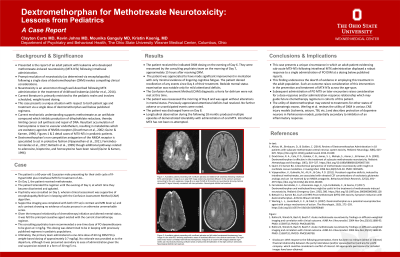Psychopharmacology and Toxicology
(138) Dextromethorphan for Methotrexate Neurotoxicity: Lessons from Pediatrics


Clayton Cottrell Milo Curts, MD (he/him/his)
Resident Physician
Ohio State University
Columbus, Ohio
Kevin Johns, MD
Assistant Clinical Professor
The Ohio State University
Hilliard, Ohio- KK
Kristin Koenig, MD
Assistant Professor
The Ohio State University College of Medicine
Columbus, Ohio 
Mounika P. Ganguly, MD
Consultation-Liaison Psychiatrist
Nationwide Children's Hospital
Columbus, Ohio
Presenting Author(s)
Co-Author(s)
Background/Significance: Neurotoxicity is an uncommon though well-described event following methotrexate administration in the treatment of childhood leukemias. Evidence for dextromethorphan’s use as a neuroprotective treatment in such circumstances has been mounting via case reports and reviews (Afshar, 2014) which are primarily restricted to the pediatric realm and involve scheduled, weight-based dosing. This case presents a unique situation with respect to both patient age and treatment via a single dose of dextromethorphan well below published regimens.
Case: Presented is the report of an adult patient with leukemia who developed methotrexate-induced neurotoxicity (MTX-NTx) following intrathecal administration as a component of their chemotherapy. Prompt resolution of neurotoxicity, as determined via presence of encephalopathy, following a single dose of dextromethorphan invokes a compelling clinical consideration for timely treatment and potential prophylaxis of MTX-NTx.
The patient is a 60-year-old Caucasian male presenting for their sixth cycle of R-HyperCVAD plus intrathecal methotrexate for treatment of ALL. On Day 1, the patient received methotrexate. The patient tolerated the regimen until the evening of Day 4, at which time they became disoriented and agitated. Psychiatry was consulted on Day 5, wherein assessment was supportive of encephalopathy. The psychiatry team recommended a one-time dose of PO dextromethorphan given at a dose of 1 mg/kg. Dosing was in in keeping with previously published regimens in pediatric populations with MTX-NTx. However, the primary team administered dextromethorphan at a dose of 0.7 mg/kg secondary to ease of administration.
The patient was reassessed the morning after receiving dextromethorphan and was appreciated to have made significant improvement in mentation. They were noted to be alert and oriented with minimal cognitive fatigue. Spouse described marked improvement within two hours of administration.
Longitudinal observation during the following 18 months has produced multiple episodes of demonstrated tolerability with administration of oral MTX, although intrathecal MTX has not been re-attempted.
Discussion: This report supports the hypothesis that dextromethorphan may serve to treat methotrexate-induced neurotoxicity without exclusive adherence to pre-existing dosage thresholds or pediatric populations. Review of literature suggests an emerging body of case reports which are supportive of dextromethorphan in both the prevention and treatment of MTX-NTx. However, reports largely remain in the domain of pediatric hematologic oncology and involve scheduled, weight-based dosing exceeding what was provided to the patient in this report.
Conclusions/Implications: This case presents a unique circumstance in which an adult patient evidencing sub-acute MTX-NTx displayed a robust response to a single administration of dextromethorphan at a dosing below published reports. This finding is underscored by the dearth of evidence on employing this treatment in the adult population; such an outcome raises consideration for use of dextromethorphan as an intervention in the prevention and treatment of MTX-NTx across the age-span. Beyond this, subsequent successful administrations of oral methotrexate on later encounters raises consideration for a dose-response and/or administration-response relationship which may guide future treatment approaches.
References:
Afshar, M., Birnbaum, D., & Golden, C. (2014). Review of Dextromethorphan Administration in 18 patients with subacute methotrexate central nervous system toxicity. Pediatric Neurology, 50(6), 625–629. https://doi.org/10.1016/j.pediatrneurol.2014.01.048
Presentation Eligibility: Not previously published or presented
Diversity, Equity, and Inclusion: This case report centers on the application of a treatment historically relegated to the pediatric population which may be effectively expanded to treat adult populations. In keeping with this, such a translation to new populations could be observed so as to characterize the potential for disparities among historically underserved minority populations in the application of novel treatments.

